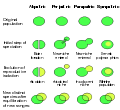Speciation
Speciation is the evolutionary process by which populations evolve to become distinct species. The biologist Ornithologist Ernst Mayr formulated the standard definition of species as groups of actually or potentially interbreeding natural populations, which are reproductively isolated from other such groups.<ref>Mayr, Ernst (1942). Systematics and the Origin of Species. Columbia University Press.</ref>
Mechanisms[edit]
Speciation depends on two separate phenomena: genetic divergence and reproductive isolation. Genetic divergence is the process where a group of organisms share a common ancestor, but due to mutations, selection and genetic drift, they accumulate independent genetic differences. Reproductive isolation involves barriers to gene flow, which can either be pre-zygotic or post-zygotic.
Genetic Divergence[edit]
Genetic divergence is the process where a group of organisms share a common ancestor, but due to mutations, selection and genetic drift, they accumulate independent genetic differences. This can lead to the formation of new species.
Reproductive Isolation[edit]
Reproductive isolation involves barriers to gene flow, which can either be pre-zygotic or post-zygotic. Pre-zygotic barriers prevent fertilization from occurring. Post-zygotic barriers prevent the formation of fertile offspring.
Types of Speciation[edit]
There are four modes of natural speciation, based on the extent to which speciating populations are isolated from one another: allopatric, peripatric, parapatric, and sympatric. Speciation may also be induced artificially, through animal husbandry, cultivation, or laboratory experiments.
Allopatric Speciation[edit]
Allopatric speciation is speciation that occurs when biological populations of the same species become vicariant, or isolated from each other to an extent that prevents or interferes with genetic interchange.
Peripatric Speciation[edit]
Peripatric speciation is a mode of speciation in which a new species is formed from an isolated peripheral population.
Parapatric Speciation[edit]
Parapatric speciation is a mode of speciation in which species are formed across large geographic distances.
Sympatric Speciation[edit]
Sympatric speciation is the process through which new species evolve from a single ancestral species while inhabiting the same geographic region.
See Also[edit]
References[edit]
<references />
Ad. Transform your life with W8MD's Budget GLP-1 injections from $75


W8MD offers a medical weight loss program to lose weight in Philadelphia. Our physician-supervised medical weight loss provides:
- Weight loss injections in NYC (generic and brand names):
- Zepbound / Mounjaro, Wegovy / Ozempic, Saxenda
- Most insurances accepted or discounted self-pay rates. We will obtain insurance prior authorizations if needed.
- Generic GLP1 weight loss injections from $75 for the starting dose.
- Also offer prescription weight loss medications including Phentermine, Qsymia, Diethylpropion, Contrave etc.
NYC weight loss doctor appointmentsNYC weight loss doctor appointments
Start your NYC weight loss journey today at our NYC medical weight loss and Philadelphia medical weight loss clinics.
- Call 718-946-5500 to lose weight in NYC or for medical weight loss in Philadelphia 215-676-2334.
- Tags:NYC medical weight loss, Philadelphia lose weight Zepbound NYC, Budget GLP1 weight loss injections, Wegovy Philadelphia, Wegovy NYC, Philadelphia medical weight loss, Brookly weight loss and Wegovy NYC
|
WikiMD's Wellness Encyclopedia |
| Let Food Be Thy Medicine Medicine Thy Food - Hippocrates |
Medical Disclaimer: WikiMD is not a substitute for professional medical advice. The information on WikiMD is provided as an information resource only, may be incorrect, outdated or misleading, and is not to be used or relied on for any diagnostic or treatment purposes. Please consult your health care provider before making any healthcare decisions or for guidance about a specific medical condition. WikiMD expressly disclaims responsibility, and shall have no liability, for any damages, loss, injury, or liability whatsoever suffered as a result of your reliance on the information contained in this site. By visiting this site you agree to the foregoing terms and conditions, which may from time to time be changed or supplemented by WikiMD. If you do not agree to the foregoing terms and conditions, you should not enter or use this site. See full disclaimer.
Credits:Most images are courtesy of Wikimedia commons, and templates, categories Wikipedia, licensed under CC BY SA or similar.
Translate this page: - East Asian
中文,
日本,
한국어,
South Asian
हिन्दी,
தமிழ்,
తెలుగు,
Urdu,
ಕನ್ನಡ,
Southeast Asian
Indonesian,
Vietnamese,
Thai,
မြန်မာဘာသာ,
বাংলা
European
español,
Deutsch,
français,
Greek,
português do Brasil,
polski,
română,
русский,
Nederlands,
norsk,
svenska,
suomi,
Italian
Middle Eastern & African
عربى,
Turkish,
Persian,
Hebrew,
Afrikaans,
isiZulu,
Kiswahili,
Other
Bulgarian,
Hungarian,
Czech,
Swedish,
മലയാളം,
मराठी,
ਪੰਜਾਬੀ,
ગુજરાતી,
Portuguese,
Ukrainian












